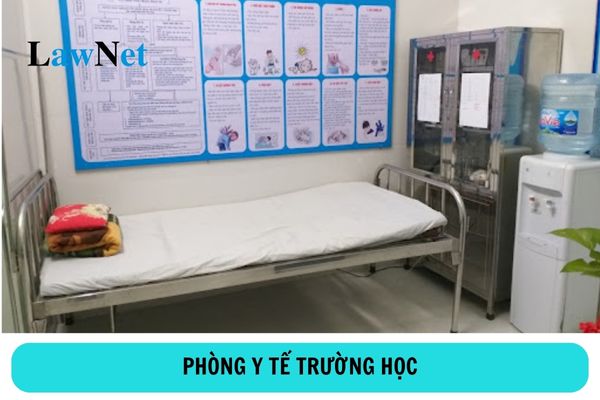What standards must school health rooms meet?
What are the Standards for a School Health Office? What are the Standards for School Health Staff?
What standards must a school health room meet?
Based on Clause 1, Article 8 of Joint Circular 13/2016/TTLT-BYT-BGDĐT, the school health room must meet the following standards:
- The school must have a separate health room, ensuring sufficient area, conveniently located for first aid, emergency care, and student health care;
- The health room of primary schools, secondary schools, high schools, multi-level schools, and specialized schools must be minimally equipped with:
+ 01 examination bed and patient bed, desk, chair, equipment cabinet, common working tools, scale, measuring tape, blood pressure monitor, thermometer, vision test board, leg and arm splints, and some essential medicines for first aid and student health care as stipulated in Decision No. 1221/QD-BYT of 2008.
+ For preschool educational institutions, specialized equipment and essential medicines suitable for the age group are required;
- Health records as per form A1/YTCS stipulated in Circular 27/2014/TT-BYT; student health monitoring records as per form No. 01 and student health summary records as per form No. 02 stipulated in Appendix No. 01 issued with Joint Circular 13/2016/TTLT-BYT-BGDĐT.

What standards must a school health room meet? (Image from Internet)
What standards must school health staff meet?
Based on Clause 2, Article 8 of Joint Circular 13/2016/TTLT-BYT-BGDĐT, school health staff must meet the following standards:
- School health staff must have professional qualifications from intermediate medical practitioners or higher. Depending on the actual conditions of the locality, schools may arrange school health staff as specified in point a, Clause 2, Article 8 of Joint Circular 13/2016/TTLT-BYT-BGDĐT or contract with commune-level health stations, hospitals, or medical examination and treatment facilities from polyclinics or higher to care for student health;
- School health staff must regularly update their professional medical knowledge through workshops, training, and professional specializations organized by the Health sector or Education sector to effectively carry out the stipulated tasks;
- School health staff have the responsibility to advise and organize the implementation according to regulations in Articles 9 and 10 of Joint Circular 13/2016/TTLT-BYT-BGDĐT and other tasks assigned by the school leadership.
Conditions for food safety in school health care?
Based on Article 6 of Joint Circular 13/2016/TTLT-BYT-BGDĐT, the following conditions for food safety in school health care must be ensured:
- Schools with boarding and semi-boarding kitchens
+ Ensure infrastructure conditions on food hygiene and safety as per Clauses 1, 2, 3, section VI, and hygiene requirements for food storage and processing activities as per Clause 5 of the National Technical Regulation (QCVN 07:2010/BYT) on infectious disease prevention in educational institutions in the national education system issued with Circular 46/2010/TT-BYT;
+ Kitchens, dining rooms (eating areas), and canteens in schools must comply with the regulations in Article 4 of Circular 30/2012/TT-BYT;
+ Staff working in school dining rooms and kitchens must meet health requirements as per Circular 15/2012/TT-BYT.
- For schools without boarding and semi-boarding kitchens, contracts must be signed with facilities having a certificate of eligibility for food safety to provide meals to students; school canteens must meet the requirements in point b, Clause 1, Article 6 of Joint Circular 13/2016/TTLT-BYT-BGDĐT.
When must schools report periodically on health activities?
Based on Clause 1, Article 11 of Joint Circular 13/2016/TTLT-BYT-BGDĐT, the following provisions apply:
Statistics, reporting, and evaluation of school health care
- Periodic and ad-hoc reports
a) Perform periodic reporting of health care activities during the school year no later than May 30 according to the report form stipulated in Appendix No. 02 issued with this Joint Circular to the commune-level health station, Department of Education and Training, Department of Education and Training according to management levels;
b) Perform ad-hoc reports upon request of the higher management authority.
- Evaluation of school health care work
Schools self-organize the evaluation of the implementation results of school health care at the end of each school year: Preschool educational institutions evaluate according to the form specified in Appendix No. 03 issued with this Joint Circular; primary schools, secondary schools, high schools, multi-level schools, and specialized schools evaluate according to the form specified in Appendix No. 04 issued with this Joint Circular.
Accordingly, schools must report periodically on health activities during the school year no later than May 30.

